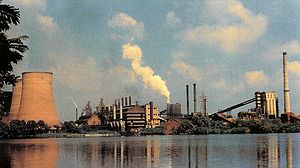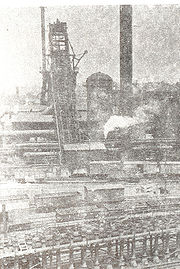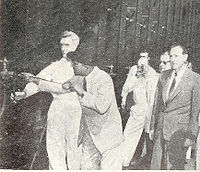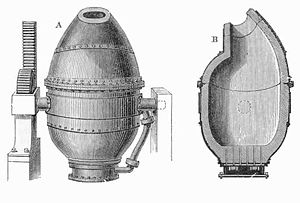
IISCO
Encyclopedia
IISCO Steel Plant of Steel Authority of India Limited
(SAIL) is located at Burnpur
, near Asansol
. The turbulent history of the plant, starting from its pioneering days, has found it a place in industrial history.
It was the second integrated steel plant, after Tata Iron and Steel Co. Ltd.
(TISCO) at Jamshedpur, to come up in India and for many years, these two were the only steel plants in the country. It has rich history that goes back to the days when James Erskine pioneered the production of iron in this country at nearby Kulti
. Modern metallurgy was introduced to India at Kulti with the setting up of the first blast furnace using coal instead of charcoal.

 In the first decade of the last century Kulti also produced steel utilising open hearth furnaces. However, the efforts did not survive the competition from imported steel. Therefore, although Kulti was the first plant in the country to produce both iron and steel, credit is normally given to TISCO because it did it on a continuous basis. World steel production was around 5 million tonnes (against more than a billion tonnes at present.)
In the first decade of the last century Kulti also produced steel utilising open hearth furnaces. However, the efforts did not survive the competition from imported steel. Therefore, although Kulti was the first plant in the country to produce both iron and steel, credit is normally given to TISCO because it did it on a continuous basis. World steel production was around 5 million tonnes (against more than a billion tonnes at present.)
Operating an industrial unit in those days was extremely difficult. The plant at Kulti changed hands many times. For some time, it was operated under the Public Works Department of the Government. That was in an age when even the concept of public sector had not germinated. Somewhere in the last decade of the nineteenth century Sir Rajendranath Mookerjee
and Sir Acquin Martin, who had together founded Martin & Co. bought over the plant at Kulti and helped it to survive.
They were also responsible for opening the first iron ore mine at Pansiraburu in Singhbhum district in what was then Bengal and now Jharkhand, in 1901. The discovery of iron ore effectively laid the foundation for the iron and steel industry in India. TISCO started operations in 1908.
 The possibility of a second steel plant in the country was opened up with disruption of supplies of iron and steel from Europe during the First World War. Burn & Co. promoted The Indian Iron & Steel Co. Ltd. in 1918. G.H.Fairhurst is credited with having founded the plant at Burnpur. The blast furnaces were not of the open top type as at Kulti and coke oven batteries were also built to provide coke for the furnaces. However, bullock carts continued to be used for transportation. The first blast furnace went into operation in 1922 and the second in 1924.
The possibility of a second steel plant in the country was opened up with disruption of supplies of iron and steel from Europe during the First World War. Burn & Co. promoted The Indian Iron & Steel Co. Ltd. in 1918. G.H.Fairhurst is credited with having founded the plant at Burnpur. The blast furnaces were not of the open top type as at Kulti and coke oven batteries were also built to provide coke for the furnaces. However, bullock carts continued to be used for transportation. The first blast furnace went into operation in 1922 and the second in 1924.
Amongst those associated with the plant at Burnpur were Sir Rajen Mookerjee and T.Leslie Martin (Sir Acquin’s son). Sir Biren Mookerjee
, Sir Rajen’s son, who had a role in the growth and development of the plant joined a few years later.
Bengal Iron was merged with IISCO in 1936. In those days, the plants used to export pig iron to Japan.
 Steel Corporation of Bengal (SCOB) set up the steel plant at Burnpur adjacent to the iron making facilities of IISCO in 1939. The two were merged and operated under the managing agency of Martin Burn in the early fifties. The plant was expanded to an annual capacity of 1 million tonnes and it achieved rated capacity in the early sixties. IISCO was a highly profit making concern and its shares were quoted on London Stock Exchange. Within the country, it had the reputation of being the best place for investment even by widows. Investments were considered safe and sound.
Steel Corporation of Bengal (SCOB) set up the steel plant at Burnpur adjacent to the iron making facilities of IISCO in 1939. The two were merged and operated under the managing agency of Martin Burn in the early fifties. The plant was expanded to an annual capacity of 1 million tonnes and it achieved rated capacity in the early sixties. IISCO was a highly profit making concern and its shares were quoted on London Stock Exchange. Within the country, it had the reputation of being the best place for investment even by widows. Investments were considered safe and sound.
IISCO owed its success largely to the efficient top management team, who steered the company most effectively. Over the years, that team included H.V.Peeling, Ashok Chaterjee, John McCracken, F.W.A.Lahmeyer and N.R.Dutt. They were management legends, long departed but still remembered for their contribution to the growth and development of the steel plant and life in the township. They took IISCO to great heights of glory. With high production and profitability, life in the townships was enriched. A new township was built at Chhotodighari. It was a model township in those days, with numbered roads lined with flowering trees, an effective sewerage system and underground electric connections.
Kulti Works pioneered the production of spun pipes in 1945. Thereafter, the foundries at Kulti were expanded and the iron making facilities were dismantled.
There were two major obstacles to modernisation of IISCO. The first was the non-availability of funds for the gigantic task. Around Rs. 5,000 crores were required for the modernisation programme. The second obstacle was the massive reduction in manpower.
In the seventies, SAIL was a loss-making organisation, entirely dependent on budgetary support of the government. The situation was reversed after V.Krishnamurthy took over as chairman of SAIL. He made SAIL a profit-making organisation and from the eighties SAIL has functioned without any budgetary support of the government. It has stood on its own feet. Krishnamurthy also initiated the programme for the modernisation of the steel plants at Durgapur, Rourkela
and Burnpur. While the programme at Durgapur and Rourkela succeeded and are bearing fruit, the modernisation of Burnpur was struck down by political and trade union intervention.
During the days of private management, IISCO had manpower of 18,000 for a production of 1 million tonnes of steel at Burnpur. In spite of decline in production, considerable additional manpower was added in the last days of private management. With government takeover, the manpower swelled to 28,000. The consortium of Japanese steel companies, which was planning for the modernisation of IISCO proposed manpower of 14,200 for a production of 2.1 million tonnes. That became a source of bitterness although officially everybody accepted the proposal formally. In today’s context, the manpower requirement for a steel plant has gone down even further. Globally, the thumb rule is 1,000 workers for a production of 1 million tonnes. In South Korea, POSCO produces 28 million tonnes with around 10,000 workers.
With the resignation of Rajiv Gandhi’s government in 1989, the proposal for the modernisation of IISCO fell through. Thereafter various proposals were mooted, including privatisation of IISCO, but nothing matured. Even with a clean balance sheet, after all loans were written off, there were no takers for IISCO against global tenders. IISCO was virtually in the dock facing the threat of being closed down. After earning profits for 14 years in a row, SAIL was once again in the red when the entire steel industry was in the doldrums from the late nineties. Things started looking up from 2003–04 and SAIL was back in profits. It has taken up a massive programme of expansion/modernisation with an investment of around Rs. 25,000 crores encompassing all its plants, after it has completed its modernisation programme costing Rs. 15,000 crores.
was associated with it for some time. Gopeswar, who later became national president of the Indian National Trade Union Congress (INTUC), operated at Burnpur and was all along been associated with IISCO. He has represented the workers on the boards of many companies. The famous strike in 1953 led to the formation of Action Committee, which later emerged as a wing of the All India Trade Union Congress (AITUC). Since its split, the Centre of Indian Trade Unions (CITU) played a big role in IISCO affairs, their leaders being Chandrasekhar Mukherjee and Bamapada Mukherjee. Amongst other leaders who need a mention are Taher Hussein and Nitish Sett of AITUC.
For many years, the trade unions and IISCO Officers’ Association have worked in unison under the banner of the Save IISCO Committee. On the positive side, the trade unions were responsible for the increase in wages and improvements in working conditions of the workers. However, it is yet to be seen as to what role they play in a completely changed scenario. Steel workers are amongst the best paid in the organised sector of Indian industry. The IISCO workforce is particularly reputed for its strong sense of belonging. Many of them are second or even third generation employees.
The programme envisages the installation of state-of-the-art environment-friendly and energy-efficient steel making technology. It will help ISP multiply its crude steel production capacity from the present 0.5 million tonnes to 2.5 million tonnes by the year 2010. Among the new facilities that will be installed as part of ISP’s expansion are a large-volume blast furnace, coke oven battery, two sinter plants, three converters with continuous billet and beam blank/bloom casters, heavy section mill of 0.6 million tonne capacity and wire rod & bar mill of 1.2 million tonne capacity. Besides increase in steel production, the new facilities will provide the plant with a competitive edge in terms of manpower productivity and other techno-economic parameters like blast furnace productivity, coke rate, energy consumption, etc.
However the expansion work has been delayed due to revision in contract and the revised date as per the consultant MECON is June 2011.
Steel Authority of India Limited
Steel Authority of India Limited from 116950 The company's current chairman is C.S Verma. With an annual production of 13.5 million metric tons, SAIL is the 14th largest steel producer in the world....
(SAIL) is located at Burnpur
Burnpur
Burnpur is an important industrial city in Asansol sub-division in the state of West Bengal, India . It is located in Bardhaman District, in the heart of the mining-industrial belt in the western periphery of the state....
, near Asansol
Asansol
Asansol is a coal mining and industrial metropolis and one of the busiest commercial centres in India. It is the second largest city and urban agglomeration in West Bengal after Kolkata and the 19th largest urban agglomeration in India. Asansol is located in the western part of the Burdwan...
. The turbulent history of the plant, starting from its pioneering days, has found it a place in industrial history.
It was the second integrated steel plant, after Tata Iron and Steel Co. Ltd.
Tata Steel
Tata Steel is a multinational steel company headquartered in Jamshedpur, India and part of Tata Group. It is the world's seventh-largest steel company, with an annual crude steel capacity of 31 million tonnes, and the largest private-sector steel company in India measured by domestic production...
(TISCO) at Jamshedpur, to come up in India and for many years, these two were the only steel plants in the country. It has rich history that goes back to the days when James Erskine pioneered the production of iron in this country at nearby Kulti
Kulti
Kulti is a city and a municipality in Bardhaman district in the Indian state of West Bengal.-Geography:Kulti is located at latitude 23°43'60N and longitude 86°50'60E at an elevation of 114 meters. The Asansol-Durgapur region is composed of undulating latterite soil. This area lies between two...
. Modern metallurgy was introduced to India at Kulti with the setting up of the first blast furnace using coal instead of charcoal.

Emergence of Kulti
James Erskine founded the Bengal Iron Works in 1870. His open top furnaces using raw coal (instead of coke as is now done), poor grade iron ore available locally and bullock carts for transportation went into operation in 1875 at Kulti, then better known as Kendwa. It was a big leap forward for Indian metallurgy. Although India had been producing steel from ancient times, all such attempts were made with charcoal. Coal was discovered in India in 1774 and coalmining started in the Asansol-Ranigunj area around 1820-1830.
Operating an industrial unit in those days was extremely difficult. The plant at Kulti changed hands many times. For some time, it was operated under the Public Works Department of the Government. That was in an age when even the concept of public sector had not germinated. Somewhere in the last decade of the nineteenth century Sir Rajendranath Mookerjee
Rajen Mookerjee
Sir Rajen Mookerjee, KCIE, KCVO was a pioneering Indian industrialist.-Early life:...
and Sir Acquin Martin, who had together founded Martin & Co. bought over the plant at Kulti and helped it to survive.
They were also responsible for opening the first iron ore mine at Pansiraburu in Singhbhum district in what was then Bengal and now Jharkhand, in 1901. The discovery of iron ore effectively laid the foundation for the iron and steel industry in India. TISCO started operations in 1908.
Burnpur gets going

Amongst those associated with the plant at Burnpur were Sir Rajen Mookerjee and T.Leslie Martin (Sir Acquin’s son). Sir Biren Mookerjee
Biren Mookerjee
Sir Biren Mookerjee was a leading industrialist who established the IISCO steel plant at Burnpur and other industrial establishments...
, Sir Rajen’s son, who had a role in the growth and development of the plant joined a few years later.
Bengal Iron was merged with IISCO in 1936. In those days, the plants used to export pig iron to Japan.

IISCO owed its success largely to the efficient top management team, who steered the company most effectively. Over the years, that team included H.V.Peeling, Ashok Chaterjee, John McCracken, F.W.A.Lahmeyer and N.R.Dutt. They were management legends, long departed but still remembered for their contribution to the growth and development of the steel plant and life in the township. They took IISCO to great heights of glory. With high production and profitability, life in the townships was enriched. A new township was built at Chhotodighari. It was a model township in those days, with numbered roads lined with flowering trees, an effective sewerage system and underground electric connections.
Kulti Works pioneered the production of spun pipes in 1945. Thereafter, the foundries at Kulti were expanded and the iron making facilities were dismantled.
Modernisation
Iron and steel technology advanced in leaps and bounds since the Second World War, along with massive growth in production globally. The technological leap forward left the plant the plant at Burnpur in shambles. Rising cost of production made the once profit making organisation a loss-making unit. Coupled with militant labour trouble in the sixties, IISCO faced a situation of near collapse in the early seventies. The management of IISCO was taken over by the government on 14 July 1972. Subsequently IISCO was nationalised and made a wholly owned subsidiary of SAIL (Steel Authority of India Ltd.). At the time of government-take over IISCO was the third largest private sector company (after TISCO and Telco) in India.There were two major obstacles to modernisation of IISCO. The first was the non-availability of funds for the gigantic task. Around Rs. 5,000 crores were required for the modernisation programme. The second obstacle was the massive reduction in manpower.
In the seventies, SAIL was a loss-making organisation, entirely dependent on budgetary support of the government. The situation was reversed after V.Krishnamurthy took over as chairman of SAIL. He made SAIL a profit-making organisation and from the eighties SAIL has functioned without any budgetary support of the government. It has stood on its own feet. Krishnamurthy also initiated the programme for the modernisation of the steel plants at Durgapur, Rourkela
Rourkela
Rourkela is located in the northwestern tip of the Indian state of Orissa at the heart of a rich mineral belt. It is situated about north of state capital Bhubaneswar.It is surrounded by a range of hills and encircled by rivers. One of the largest steel plants of the Steel Authority of India...
and Burnpur. While the programme at Durgapur and Rourkela succeeded and are bearing fruit, the modernisation of Burnpur was struck down by political and trade union intervention.
During the days of private management, IISCO had manpower of 18,000 for a production of 1 million tonnes of steel at Burnpur. In spite of decline in production, considerable additional manpower was added in the last days of private management. With government takeover, the manpower swelled to 28,000. The consortium of Japanese steel companies, which was planning for the modernisation of IISCO proposed manpower of 14,200 for a production of 2.1 million tonnes. That became a source of bitterness although officially everybody accepted the proposal formally. In today’s context, the manpower requirement for a steel plant has gone down even further. Globally, the thumb rule is 1,000 workers for a production of 1 million tonnes. In South Korea, POSCO produces 28 million tonnes with around 10,000 workers.
With the resignation of Rajiv Gandhi’s government in 1989, the proposal for the modernisation of IISCO fell through. Thereafter various proposals were mooted, including privatisation of IISCO, but nothing matured. Even with a clean balance sheet, after all loans were written off, there were no takers for IISCO against global tenders. IISCO was virtually in the dock facing the threat of being closed down. After earning profits for 14 years in a row, SAIL was once again in the red when the entire steel industry was in the doldrums from the late nineties. Things started looking up from 2003–04 and SAIL was back in profits. It has taken up a massive programme of expansion/modernisation with an investment of around Rs. 25,000 crores encompassing all its plants, after it has completed its modernisation programme costing Rs. 15,000 crores.
Trade union activity
The first trade union was established in IISCO in 1943. Prof. Abdul BariProfessor Abdul Bari
Abdul Bari was an Indian academic and social reformer. He was born in 1892 in Sahabad, Village Kansua of Jahanabad District in Bihar. He graduated in 1918 and later engaged in post-graduate studies in History in 1920 at Patna University...
was associated with it for some time. Gopeswar, who later became national president of the Indian National Trade Union Congress (INTUC), operated at Burnpur and was all along been associated with IISCO. He has represented the workers on the boards of many companies. The famous strike in 1953 led to the formation of Action Committee, which later emerged as a wing of the All India Trade Union Congress (AITUC). Since its split, the Centre of Indian Trade Unions (CITU) played a big role in IISCO affairs, their leaders being Chandrasekhar Mukherjee and Bamapada Mukherjee. Amongst other leaders who need a mention are Taher Hussein and Nitish Sett of AITUC.
For many years, the trade unions and IISCO Officers’ Association have worked in unison under the banner of the Save IISCO Committee. On the positive side, the trade unions were responsible for the increase in wages and improvements in working conditions of the workers. However, it is yet to be seen as to what role they play in a completely changed scenario. Steel workers are amongst the best paid in the organised sector of Indian industry. The IISCO workforce is particularly reputed for its strong sense of belonging. Many of them are second or even third generation employees.
Modernisation inaugurated
Prime Minister Manmohan Singh inaugurated the work for a Rs. 9,600 crore modernisation programme at Burnpur on 24 December 2006. It is the largest investment in West Bengal in the last ten years.The programme envisages the installation of state-of-the-art environment-friendly and energy-efficient steel making technology. It will help ISP multiply its crude steel production capacity from the present 0.5 million tonnes to 2.5 million tonnes by the year 2010. Among the new facilities that will be installed as part of ISP’s expansion are a large-volume blast furnace, coke oven battery, two sinter plants, three converters with continuous billet and beam blank/bloom casters, heavy section mill of 0.6 million tonne capacity and wire rod & bar mill of 1.2 million tonne capacity. Besides increase in steel production, the new facilities will provide the plant with a competitive edge in terms of manpower productivity and other techno-economic parameters like blast furnace productivity, coke rate, energy consumption, etc.
However the expansion work has been delayed due to revision in contract and the revised date as per the consultant MECON is June 2011.
See also
- Global steel industry trendsGlobal steel industry trendsThe global steel industry has been going through major changes since 1970. China has emerged as a major producer and consumer, as has India to a lesser extent. Consolidation has been rapid in Europe.-Material for development and war:...
- for an overview of the entire industry.

